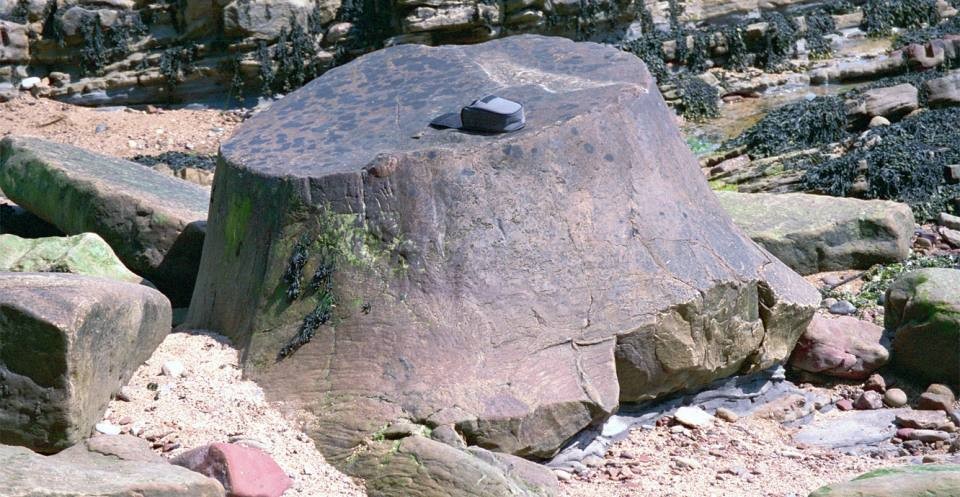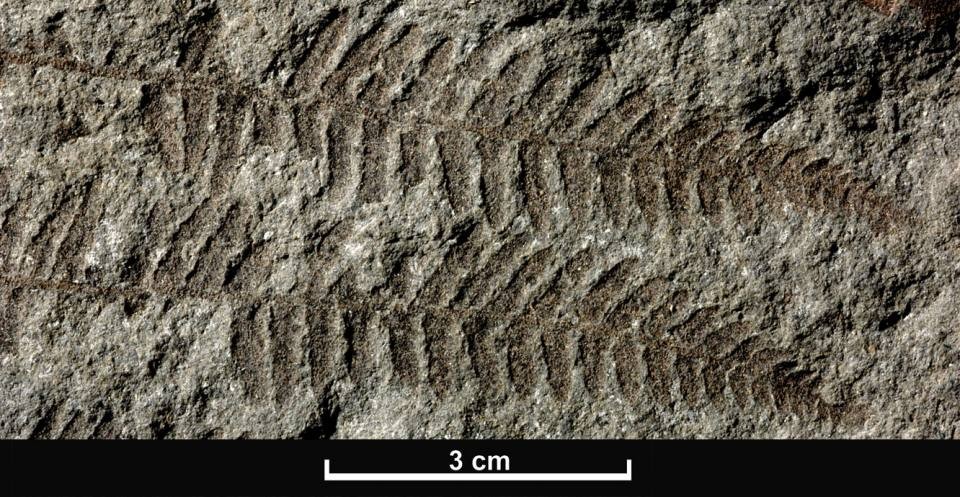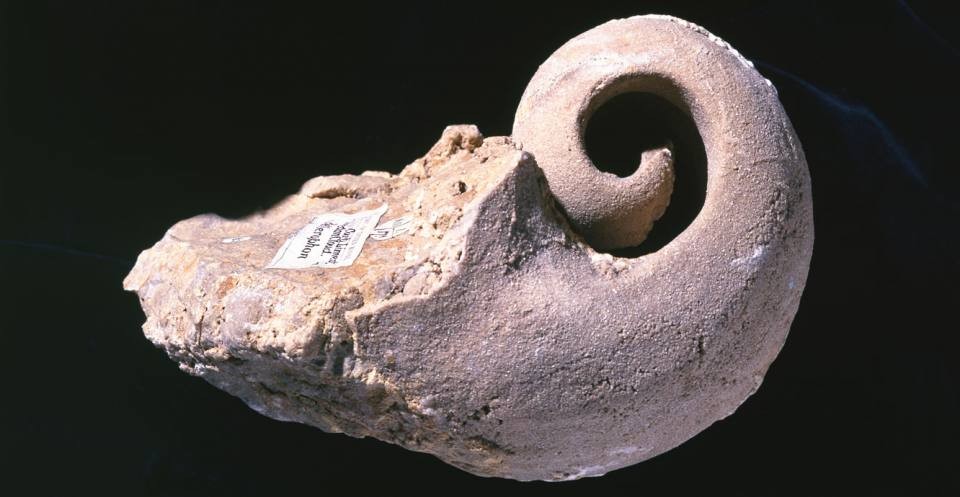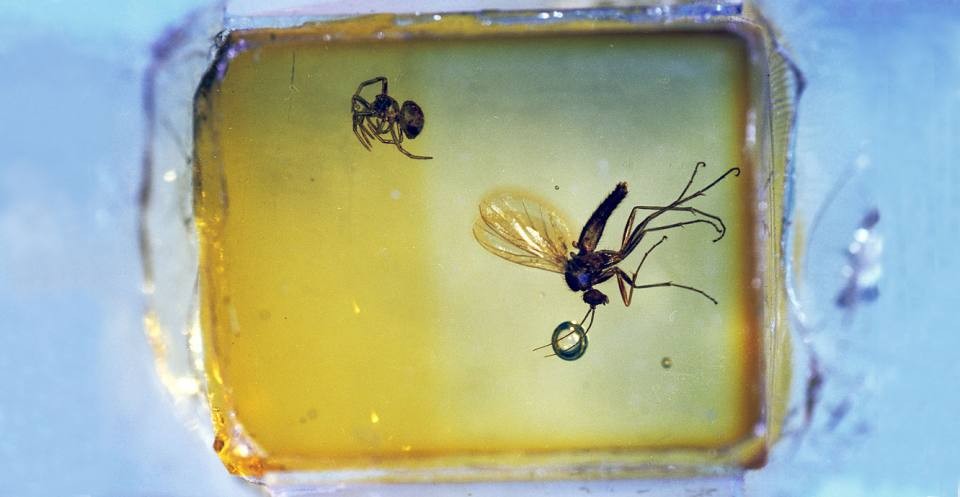What Can We Learn About Fossils? Fossils, the preserved remnants of ancient life, offer a captivating window into Earth’s history, evolution, and changing environments, all meticulously explained here at LEARNS.EDU.VN. Delving into fossil study, also known as paleontology, equips us with crucial insights into the origin of species, the transformation of our planet, and the interconnectedness of life. Explore diverse fossil types, their formation processes, and their significance in understanding our world’s past and future, with LEARNS.EDU.VN.
1. What Are Fossils and Why Are They Important?
Fossils are the preserved remains or traces of ancient organisms, typically more than 10,000 years old. These remnants can include bones, shells, teeth, footprints, burrows, and even fossilized dung. The study of fossils provides invaluable information about the history of life on Earth, evolutionary processes, past environments, and the interconnectedness of all living things.
1.1 What Exactly Defines a Fossil?
A fossil is any preserved trace of past life. According to the University of California Museum of Paleontology, fossils are not just limited to the bones and shells of extinct animals. They can also include:
- Body Fossils: Actual remains of organisms, such as bones, teeth, shells, and leaves.
- Trace Fossils: Evidence of an organism’s activity, like footprints, burrows, and fossilized dung (coprolites).
- Chemical Fossils: Chemical compounds that indicate the presence of ancient life.
1.2 Why Should We Study Fossils?
Studying fossils allows us to:
- Understand Evolution: Fossils provide direct evidence of how organisms have changed over time, supporting the theory of evolution by natural selection, as Charles Darwin explained in “On the Origin of Species”.
- Reconstruct Past Environments: The types of fossils found in a particular location can tell us about the climate, geography, and ecosystems that existed there in the past. According to research from the Paleontological Society, fossil plants and animals are indicators of their environment.
- Date Rocks and Geological Events: Certain fossils, known as index fossils, are particularly useful for dating rock layers and correlating geological events across different regions. The Natural History Museum explains that ammonites, for instance, are excellent index fossils for the Mesozoic Era.
- Predict Future Environmental Changes: By studying how organisms responded to past environmental changes, we can gain insights into how modern species might respond to current challenges like climate change.
- Trace the Origins of Humans: Fossil evidence is crucial in understanding the evolutionary history of humans, tracing our lineage back millions of years and shedding light on our relationship to other primates. The Smithsonian National Museum of Natural History has extensive collections of hominid fossils that provide insights into human evolution.
- Discover Resources: Fossils such as foraminifera help in oil and gas exploration. According to research by the Energy Institute, the presence and distribution of these microfossils can help identify potential petroleum reservoirs.
1.3 What Can Different Types of Fossils Tell Us?
Different types of fossils provide unique insights:
- Plant Fossils: Reveal information about past climates, vegetation types, and the evolution of plant life.
- Animal Fossils: Shed light on the evolution of animal species, their behavior, and their interactions with their environment.
- Microfossils: Tiny fossils, such as pollen grains and foraminifera, are useful for dating rocks and reconstructing past environments in detail.
- Trace Fossils: Provide clues about the behavior of ancient organisms, such as how they moved, fed, and interacted with each other.
2. How Do Fossils Form? The Fossilization Process
Fossilization is a rare and complex process that requires specific conditions. Most organisms decompose rapidly after death, but under certain circumstances, their remains can be preserved as fossils.
2.1 What Conditions Favor Fossilization?
The key conditions that promote fossilization include:
- Rapid Burial: Quick burial in sediment protects remains from scavengers, weathering, and decomposition.
- Hard Body Parts: Organisms with hard body parts, such as bones, shells, and teeth, are more likely to fossilize than those with soft bodies.
- Anoxic Environment: Low-oxygen environments slow down decomposition, increasing the chances of fossilization.
- Presence of Minerals: Mineral-rich waters can infiltrate the remains and replace organic material with durable minerals, such as silica or calcium carbonate.
2.2 What Are the Main Types of Fossilization?
There are several different ways that fossils can form:
- Petrification/Permineralization: This is the most common type of fossilization. Mineral-rich fluids seep into the porous spaces of bones or wood, gradually replacing the organic material with minerals. This process turns the remains into stone.
- Compression: Occurs when the weight of overlying sediments compresses the remains, leaving a flattened, two-dimensional imprint in the rock. This is common for plant fossils.
- Molds and Casts: If the original remains dissolve away, they can leave a void (mold) in the rock. If this void is later filled with minerals, it forms a cast of the original object.
- Preservation: In rare cases, entire organisms can be preserved intact, such as insects trapped in amber (fossilized tree resin) or animals frozen in ice.
- Carbonization: In this process, the organic material is reduced to a thin film of carbon on the surface of the rock. This is often seen in plant fossils.
- Recrystallization: Original minerals in the organism’s body change in form but not composition. For example, aragonite might recrystallize into calcite.
2.3 Where Are Fossils Typically Found?
Fossils are most commonly found in sedimentary rocks, such as sandstone, limestone, and shale. These rocks are formed from layers of sediment that accumulate over time, burying the remains of organisms. According to the U.S. Geological Survey (USGS), sedimentary rocks are the most likely to contain fossils due to their formation processes.
3. Why Fossils Matter: What Can We Learn From Them?
Fossils are more than just interesting rocks. They are valuable sources of information that can teach us about a wide range of topics.
3.1 Fossils and the History of Life
Fossils provide a direct record of the history of life on Earth. By studying fossils, we can:
- Trace the Evolution of Species: Fossils show how organisms have changed over time, providing evidence for the theory of evolution by natural selection. The fossil record demonstrates that life has evolved from simple to more complex forms over millions of years.
- Identify Extinct Species: Fossils allow us to identify species that no longer exist, such as dinosaurs, trilobites, and mammoths.
- Understand Phylogenetic Relationships: Fossils help us to reconstruct the evolutionary relationships between different groups of organisms. By comparing the anatomical features of fossils, we can determine how closely related different species are.
3.2 Fossils and Past Environments
Fossils can also tell us about the environments that existed in the past. By studying the types of fossils found in a particular location, we can infer:
- Climate: Plant fossils and the chemical composition of fossil shells can provide information about past temperatures and precipitation levels.
- Geography: The distribution of fossils can tell us how continents have moved over time and how landmasses were connected in the past.
- Ecosystems: Fossils can reveal the types of plants and animals that lived together in the past, allowing us to reconstruct ancient ecosystems.
3.3 Fossils and Geological Time
Fossils are essential tools for dating rocks and understanding geological time. Certain fossils, known as index fossils, are particularly useful for this purpose.
- Index Fossils: These are fossils of organisms that lived for a relatively short period of time and were geographically widespread. Index fossils can be used to correlate rock layers of the same age in different locations.
- Relative Dating: By comparing the fossils found in different rock layers, geologists can determine the relative ages of the layers.
- Absolute Dating: Fossils can also be used to determine the absolute age of rocks using radiometric dating techniques. By measuring the decay of radioactive isotopes in fossils, scientists can determine how long ago the organism lived.
4. Examples of Significant Fossil Discoveries
Numerous fossil discoveries have significantly advanced our understanding of the history of life on Earth. Here are a few notable examples:
- Archaeopteryx: This fossil, discovered in Germany in the 1860s, is a transitional fossil between dinosaurs and birds. It has features of both groups, such as feathers and wings like birds, but also teeth and a bony tail like dinosaurs.
- Lucy: This is the fossilized skeleton of a female hominin (Australopithecus afarensis) discovered in Ethiopia in 1974. Lucy lived about 3.2 million years ago and is one of the most complete hominin fossils ever found. She has provided valuable insights into the evolution of bipedalism (walking on two legs) in humans.
- Burgess Shale Fossils: Located in British Columbia, Canada, the Burgess Shale is a fossil-rich deposit containing a diverse array of soft-bodied organisms from the Cambrian period (about 508 million years ago). These fossils provide a unique glimpse into the early evolution of animals.
- Tiktaalik: This fossil, discovered in the Canadian Arctic in 2004, is a transitional fossil between fish and tetrapods (four-legged vertebrates). Tiktaalik had features of both groups, such as gills and scales like fish, but also a neck and wrist-like bones that allowed it to support itself on land.
- Sinosauropteryx: Discovered in China, Sinosauropteryx was one of the first dinosaurs found with fossilized feathers, providing strong evidence for the link between dinosaurs and birds.
5. How Fossils Help Us Understand Evolution
Fossils offer compelling evidence for evolution, demonstrating how life on Earth has changed over millions of years.
5.1 Transitional Fossils
Transitional fossils display a mix of features from different groups of organisms, illustrating evolutionary transitions. The archaeopteryx, for example, exhibits reptilian characteristics like teeth and a tail alongside avian features like feathers and wings, confirming a critical link between reptiles and birds. Similarly, the tiktaalik, possessing traits of both fish and tetrapods, provides insights into the move from aquatic to terrestrial life.
5.2 Fossil Records
The sequence of fossils found in different rock layers provides a chronological record of evolution. Simple organisms appear in older rocks, while more complex organisms appear in younger rocks. This pattern supports the idea that life has evolved from simple to more complex forms over time.
5.3 Comparative Anatomy
By comparing the anatomical features of fossils with those of living organisms, we can identify similarities and differences that reflect evolutionary relationships. For example, the bones in the forelimbs of humans, bats, and whales are all homologous structures, meaning that they share a common ancestry.
5.4 Molecular Evidence
DNA analysis of living organisms confirms the evolutionary relationships suggested by the fossil record. Organisms that are closely related based on fossil evidence also tend to have similar DNA sequences.
6. The Role of Fossils in Understanding Climate Change
Fossils provide valuable information about past climates and how organisms have responded to climate change in the past.
6.1 Past Climate Indicators
Fossils can be used to reconstruct past climates. For example:
- Pollen Grains: The types of pollen grains found in a particular location can tell us about the vegetation that grew there in the past, which can be used to infer past temperatures and precipitation levels.
- Fossil Shells: The chemical composition of fossil shells can provide information about the temperature and salinity of the water in which the organism lived.
- Tree Rings: Fossilized tree rings can provide information about past climate variability, such as droughts and floods.
6.2 Responses to Climate Change
Fossils can also tell us how organisms have responded to climate change in the past. For example:
- Range Shifts: As the climate changes, species may shift their geographic ranges to stay within their preferred temperature and precipitation zones.
- Evolutionary Adaptations: Organisms may evolve new adaptations to cope with changing climate conditions.
- Extinctions: If organisms are unable to adapt to changing climate conditions, they may go extinct.
6.3 Lessons for the Future
By studying how organisms have responded to climate change in the past, we can gain insights into how modern species might respond to current challenges like global warming. This information can help us to develop strategies to protect biodiversity and mitigate the impacts of climate change.
7. Where Can You See Fossils?
Fossils are displayed in numerous museums around the globe, providing opportunities for the public to learn about the history of life and our planet.
7.1 Museums
Some of the most renowned museums for viewing fossils include:
- Smithsonian National Museum of Natural History (Washington, D.C.): This museum has an extensive collection of fossils, including dinosaur skeletons, hominin fossils, and fossils from the Burgess Shale.
- American Museum of Natural History (New York City): The AMNH has a world-renowned paleontology department and displays a wide variety of fossils, including dinosaur skeletons, mammal fossils, and fossils from the La Brea Tar Pits.
- Natural History Museum (London): This museum has a vast collection of fossils from around the world, including dinosaur skeletons, fossil plants, and fossils from the Ice Age.
- Royal Tyrrell Museum of Palaeontology (Drumheller, Alberta, Canada): This museum is dedicated to the study of dinosaurs and has an impressive collection of dinosaur fossils from the Canadian Badlands.
- Musée National d’Histoire Naturelle (Paris): This museum has a diverse collection of fossils, including dinosaur skeletons, mammal fossils, and fossil plants.
7.2 Fossil Parks and Sites
In addition to museums, there are also many fossil parks and sites where you can see fossils in their natural context. Some notable examples include:
- Dinosaur National Monument (Colorado and Utah, USA): This park has a quarry containing thousands of dinosaur fossils embedded in a rock layer.
- La Brea Tar Pits (Los Angeles, California, USA): These tar pits have preserved the fossils of Ice Age mammals, such as saber-toothed cats, mammoths, and dire wolves.
- Messel Pit Fossil Site (Germany): This UNESCO World Heritage Site is an old oil shale quarry that has yielded exceptionally well-preserved fossils of plants and animals from the Eocene epoch (about 48 million years ago).
- Joggins Fossil Cliffs (Nova Scotia, Canada): These cliffs contain fossils of plants and animals from the Carboniferous period (about 310 million years ago), including the earliest known reptiles.
8. What Careers Involve Studying Fossils?
If you are fascinated by fossils and want to make a career out of studying them, there are several options available.
8.1 Paleontologist
Paleontologists are scientists who study fossils to learn about the history of life on Earth. They may work in museums, universities, or government agencies. Paleontologists conduct research, collect fossils, analyze data, and publish their findings in scientific journals. They require a strong background in geology, biology, and paleontology.
8.2 Geologist
Geologists study the Earth, its materials, and its processes. Some geologists specialize in paleontology, while others may work in related fields such as stratigraphy (the study of rock layers) or sedimentology (the study of sediments). Geologists may work in the oil and gas industry, environmental consulting, or government agencies.
8.3 Museum Curator
Museum curators are responsible for managing and caring for museum collections. They may work with fossils, artifacts, or other types of specimens. Curators conduct research, develop exhibits, and educate the public about their collections.
8.4 Science Educator
Science educators teach science to students of all ages. They may work in schools, museums, or other educational institutions. Science educators use fossils and other resources to engage students in learning about the history of life and the Earth.
9. Latest Discoveries in Paleontology
Paleontology is an ever-evolving field, with new discoveries constantly reshaping our understanding of prehistoric life. Here’s a glimpse into some recent groundbreaking finds:
| Discovery | Location | Significance |
|---|---|---|
| Oldest Animal Fossil | Stirling Range, Western Australia | Discovery of Dickinsonia fossils, dating back 558 million years, confirms it as the earliest known animal, pushing back the timeline of animal evolution. |
| New Armored Dinosaur Species | Chile | The Stegouros elengassen fossil, exhibiting a unique tail with flat, blade-like structures, offers new insights into armored dinosaur evolution in the Southern Hemisphere. |
| Dinosaur Embryo Inside Fossilized Egg | Ganzhou, China | The “Baby Yingliang” fossil, a perfectly preserved dinosaur embryo preparing to hatch, provides invaluable details about dinosaur development and its connection to modern birds. |
| Fossil of Giant Prehistoric Penguin | New Zealand | Unearthing of the Kumimanu fordycei, a penguin species that lived approximately 60-55 million years ago, which stood at around 5 feet 3 inches (1.6 meters) tall and weighed up to 340 pounds (154 kg). |




10. FAQ: Common Questions About Fossils
- How old does something have to be to be considered a fossil?
- Typically, an object must be at least 10,000 years old to be considered a fossil, aligning with the end of the last glacial period.
- Can fossils be found anywhere in the world?
- Fossils can be found worldwide, but are more common in sedimentary rocks that allow for preservation over millennia.
- Is it legal to collect fossils?
- The legality of fossil collecting depends on the location. Many countries and regions have specific laws regulating fossil collecting to protect paleontological resources.
- What is the difference between a fossil and an artifact?
- Fossils are the remains of ancient life forms, while artifacts are objects made or modified by humans.
- How do scientists determine the age of fossils?
- Scientists use various dating methods, including relative dating (comparing the positions of rock layers) and absolute dating (radiometric dating) to determine the age of fossils.
- Can soft tissues be fossilized?
- Yes, but it is rare. Under exceptional conditions, soft tissues like skin, muscles, and organs can be preserved.
- What is the largest fossil ever found?
- The largest fossil ever found is the Patagotitan mayorum, a titanosaur that measured approximately 122 feet (37 meters) long.
- Do all organisms fossilize?
- No, most organisms do not fossilize. Fossilization is a rare process that requires specific conditions.
- What is an index fossil?
- An index fossil is a fossil that is used to define and identify geologic periods. To be an index fossil, the fossil must be widely distributed and have existed for a relatively short period.
- Why are fossils important for understanding climate change?
- Fossils provide a record of how organisms have responded to climate changes in the past, which can help scientists predict how modern species might respond to current climate change.
Understanding fossils is crucial for grasping the history of life, evolution, past environments, and geological time scales. They offer insights into Earth’s ever-changing landscape and the organisms that have inhabited it.
Ready to dig deeper into the world of paleontology and unearth more fascinating facts about fossils? Visit LEARNS.EDU.VN today for a wealth of educational resources, expert insights, and engaging courses that will expand your knowledge and ignite your curiosity. Whether you’re a student, educator, or lifelong learner, learns.edu.vn is your gateway to discovering the wonders of the past and shaping a brighter future. Contact us at 123 Education Way, Learnville, CA 90210, United States, or reach out via Whatsapp at +1 555-555-1212. Let’s explore the world together!